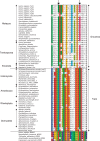The Unicellular Ancestry of Groucho-Mediated Repression and the Origins of Metazoan Transcription Factors
- PMID: 27189982
- PMCID: PMC4943189
- DOI: 10.1093/gbe/evw118
The Unicellular Ancestry of Groucho-Mediated Repression and the Origins of Metazoan Transcription Factors
Abstract
Groucho is a co-repressor that interacts with many transcription factors playing a crucial role in animal development. The evolutionary origins of Groucho are not clear. It is generally regarded as being a distinct animal-specific protein, although with similarities to the yeast Tup-like proteins. Here, it is shown that Groucho has true orthologs in unicellular relatives of animals. Based on their phylogenetic distribution, and an analysis of ligand-binding residues, these genes are unlikely to be orthologs of the fungal Tup-like genes. By identifying conserved candidate Groucho interaction motifs (GIMs) in nonmetazoan transcription factors, it is demonstrated that the details of molecular interactions between Groucho and transcription factors are likely to have been established prior to the origin of animals, but that the association of GIMs with many transcription factor types can be regarded as a metazoan innovation.
Keywords: animal evolution; transcription factor evolution; transcriptional repression.
© The Author 2016. Published by Oxford University Press on behalf of the Society for Molecular Biology and Evolution.
Figures





References
-
- Chen G, Courey AJ. 2000. Groucho/TLE family proteins and transcriptional repression. Gene 249:1–16. - PubMed
MeSH terms
Substances
LinkOut - more resources
Full Text Sources
Other Literature Sources

